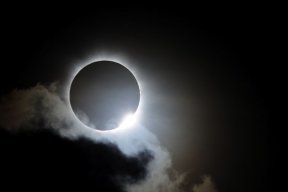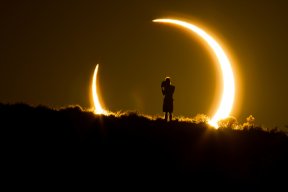
By: Dr. Linda Chous, Chief Eye Care Officer, UnitedHealthcare
The first total eclipse of the sun to span coast to coast across the U.S. mainland in almost a century will be visible Monday, Aug. 21, for people in Illinois, where eclipse coverage will exceed 90 percent. This rare celestial event is a spectacular occurrence; however, there are precautions people should take to help maintain their eye health while witnessing the spectacle in its full glory. Looking at a solar eclipse without proper protection can cause serious eye damage, including blurry vision that can last months, or even permanent problems. The most important tip is to have proper eclipse-viewing glasses, which are heavily tinted – much more so than regular sunglasses – to protect your eyes as you look at the sun. Certified eclipse-viewing glasses will enable you to see the moon track across the orb of the sun until it creates a total eclipse, revealing the sun’s brilliant corona.
A solar eclipse occurs when the moon blocks any part of the sun. But on Aug. 21, anyone within a roughly 70-mile-wide path from Oregon to South Carolina will be able to experience a total solar eclipse for about 2 minutes, weather permitting. Millions more, including people in Illinois, will be able to witness a partial eclipse. In preparation for this rare event, UnitedHealthcare is donating 10,000 solar-eclipse glasses, as well as educational materials with tips to safely view the eclipse, to schools and the Boys & Girls Clubs of America. Here are five tips to help safely view the solar eclipse, according to the American Optometric Association:

1. It is unsafe for anyone to look directly at the sun at any time or during a solar eclipse, other than if you are located in the path of totality during the brief total phase of the eclipse.
2. Use approved solar eclipse glasses and avoid fake viewers that are being sold. Read and follow any instructions packaged with or printed on the glasses.
3. Do not look at the sun through a camera, telescope, binoculars or any other optical device while using your eclipse glasses, as the concentrated solar rays can damage the filter, enter your eyes and cause serious injury.
4. Eclipse glasses should be removed only once the moon completely blocks the sun along the path of totality. Once the sun reappears, glasses should be replaced.
5. Visit a local eye care professional for a comprehensive exam if you or a family member experience discomfort or vision problems following the eclipse.
The upcoming solar eclipse should be a fun and educational opportunity as long as you take the necessary precautions. If you miss this spectacle, the next time a total solar eclipse will traverse the entire U.S. mainland will be on Aug. 12, 2045.











